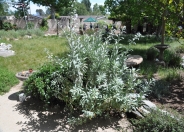
Common name: White Sage
Botanical name: Salvia apiana
This woody shrub has long stiff stems with gray green, wrinkled evergreen leaves when juvenile, changing to smooth and white with time. Fragrant white flowers bloom in the spring, attracting bees. Prune after bloom time to shape shrub. It provides a strong structural form as a garden focal point. It can reach 6' tall and wide; and is considered slow growing. Plant in full sun with well draining soil. Established plants need very little summer water. Leaves have been used for herbal teas and for medicinal purposes.
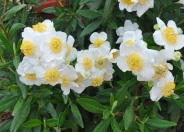
Common name: Bush Anemone
Botanical name: Carpenteria californica
This CA native is a dense, clean evergreen shrub that grows 4'-8' high and 5' wide. It is tolerant of sun or shade. It has white fragrant flowers from May through August.
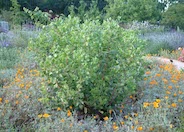
Common name: Dr. Hurd Manzanita
Botanical name: Arctostaphylos manzanita 'Dr. Hurd'
This is a large shrub with showy bark that reaches 8'-20' tall and wide. It has dark red bark, large pale green leaves and white to pink flower clusters that bloom from February to March.
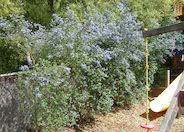
Common name: Skylark Mountain Lilac
Botanical name: Ceanothus thyrsiflorus 'Skylark'
Ceanothus Skylark™ is a good choice for small gardens. This lush green, compact Ceanothus thyrsiflorus cultivar flowers profusely and later than all other ceanothus extending your flower season into early summer. Dark blue flower spikes appear in spring lasting into summer, and some flowering will occur again in fall. It is slow growing to 3-6 ft tall with 5 foot spread making it ideal for smaller spaces. Plant in full sun on the coast or in part shade inland. Skylark performs best in heavier clay soils but will tolerate sandier soils if needed. Ceanothus are favorites of butterflies and pollinators, adding to their landscape value.

Common name: Coast Redwood
Botanical name: Sequoia sempervirens
This conifer is one of the longest living plants in the world and tallest also, one measuring 321' tall! Typically, this tree will quickly grow 100' tall and 30' wide in commercial cultivation. Leaves look like needles, are evergreen and dark green colored. Flowers are inconspicuous. Brown cones appear in fall and winter. Bark is reddish brown, furrowed, and attractive. This tree does well in full sun in cool summer climates but needs afternoon shade in warmer areas. It needs well draining, acidic, moist soil. Great shade tree. Used as bonsai specimens. Can take coastal conditions of fog and marine layer but cannot be planted at beach. Foliage and bark are aromatic.
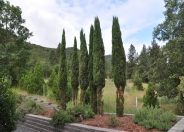
Common name: Italian Cypress
Botanical name: Cupressus sempervirens 'Stricta'
Italian Cypress is often associated with Italian and Spanish architecture, providing columns in the landscape. It can quickly reach 40' tall and 3'-4' wide. 'Stricta' is compact, dense, columnar and produces long, straight branches with dark green foliage. Birds use the conifer as nesting and refuge. It does best in full sun with well draining soil. It is drought tolerant once it's established. It is a narrower version of the parent plant.
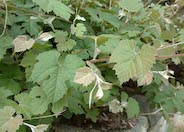
Common name: California Wild Grape
Botanical name: Vitis californica
The California Wild Grape is a woody deciduous vine with round large leaves. Small fragrant blooms appear in spring and berry clusters appear in the summer. This vine has sprawling , climbing growth habit. The California Wild grape is native to CA. It prefers full sun and well draining soil with regular watering.
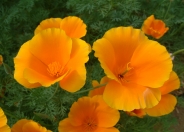
Common name: California Poppy
Botanical name: Eschscholzia californica
The California State Flower. This small annual (sometimes acts as a perennial) plant will grow to less than 1' tall and has light, small blue green leaves with gold and orange flowers that bloom in spring and summer. It is an aggressive grower and can get away from you in a residential garden space. Plant it in spaces where it is alright for it to roam.
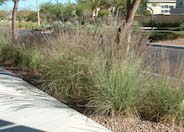
Common name: Lindheimer's Muhly
Botanical name: Muhlenbergia lindheimeri
Lindheimers Muhly is native to both Mexico and Texas. It is a clump-forming grass. It is a winter dormant grass in cold climates, but usually semi-deciduous in mild climates. It has blue-gray foliage and the flower spikes can get 5 ' tall. The flowers start out in purple and age to grey. It is a full sun plant that does well with regular water. It can do fine in low water conditions and can tolerate some shade.
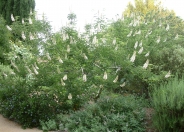
Common name: California Buckeye
Botanical name: Aesculus californica
The Aesculus californica is a tree that is interesting year-round. Creamy pink or white fragrant flowers bloom in the spring. When late summer arrives, these leaves drop to unveil pear-shaped fruits. It should be noted that these flowers are poisonous. Buckeye has a decorative bark and branch structure. It slowly grows to 15' tall. It needs regular water for a few years and then will become drought tolerant.
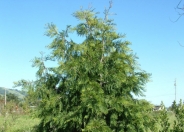
Common name: Incense Cedar
Botanical name: Calocedrus decurrens
The Cedar is an attractive, stiff, narrow evergreen tree which has a columnar growing pattern and maintains a central leader. The foliage is aromatic, dark green and needle-like, while the coarse bark has an attractive cinnamon red-brown coloring. The cedar retains its color in winter and under good cultural conditons, will maintain its foliage to the ground. It grows slowly to about 30' tall and 8'-12' wide. Brown cones are on the tree most of the year, attracting birds for the seeds.